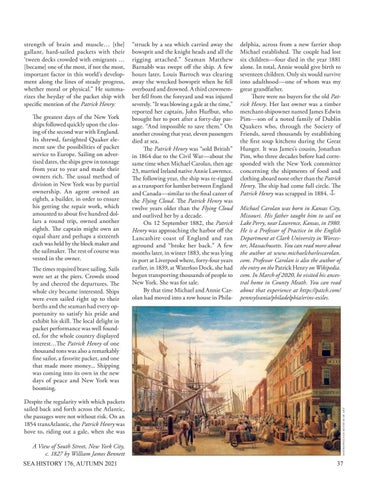The greatest days of the New York ships followed quickly upon the closing of the second war with England. Its shrewd, farsighted Quaker element saw the possibilities of packet service to Europe. Sailing on advertised dates, the ships grew in tonnage from year to year and made their owners rich. The usual method of division in New York was by partial ownership. An agent owned an eighth, a builder, in order to ensure his getting the repair work, which amounted to about five hundred dollars a round trip, owned another eighth. The captain might own an equal share and perhaps a sixteenth each was held by the block maker and the sailmaker. The rest of course was vested in the owner. The times required brave sailing. Sails were set at the piers. Crowds stood by and cheered the departures. The whole city became interested. Ships were even sailed right up to their berths and the seaman had every opportunity to satisfy his pride and exhibit his skill. The local delight in packet performance was well founded, for the whole country displayed interest…The Patrick Henry of one thousand tons was also a remarkably fine sailor, a favorite packet, and one that made more money... Shipping was coming into its own in the new days of peace and New York was booming. Despite the regularity with which packets sailed back and forth across the Atlantic, the passages were not without risk. On an 1854 transAtlantic, the Patrick Henry was hove to, riding out a gale, when she was A View of South Street, New York City, c. 1827 by William James Bennett
“struck by a sea which carried away the bowsprit and the knight heads and all the rigging attached.” Seaman Matthew Barnabb was swept off the ship. A few hours later, Louis Barroch was clearing away the wrecked bowsprit when he fell overboard and drowned. A third crewmember fell from the foreyard and was injured severely. “It was blowing a gale at the time,” reported her captain, John Hurlbut, who brought her to port after a forty-day passage. “And impossible to save them.” On another crossing that year, eleven passengers died at sea. The Patrick Henry was “sold British” in 1864 due to the Civil War—about the same time when Michael Carolan, then age 23, married Ireland native Annie Lawrence. The following year, the ship was re-rigged as a transport for lumber between England and Canada—similar to the final career of the Flying Cloud. The Patrick Henry was twelve years older than the Flying Cloud and outlived her by a decade. On 12 September 1882, the Patrick Henry was approaching the harbor off the Lancashire coast of England and ran aground and “broke her back.” A few months later, in winter 1883, she was lying in port at Liverpool where, forty-four years earlier, in 1839, at Waterloo Dock, she had begun transporting thousands of people to New York. She was for sale. By that time Michael and Annie Carolan had moved into a row house in Phila-
delphia, across from a new farrier shop Michael established. The couple had lost six children—four died in the year 1881 alone. In total, Annie would give birth to seventeen children. Only six would survive into adulthood—one of whom was my great grandfather. There were no buyers for the old Patrick Henry. Her last owner was a timber merchant-shipowner named James Edwin Pim—son of a noted family of Dublin Quakers who, through the Society of Friends, saved thousands by establishing the first soup kitchens during the Great Hunger. It was James’s cousin, Jonathan Pim, who three decades before had corresponded with the New York committee concerning the shipments of food and clothing aboard none other than the Patrick Henry. The ship had come full circle. The Patrick Henry was scrapped in 1884. Michael Carolan was born in Kansas City, Missouri. His father taught him to sail on Lake Perry, near Lawrence, Kansas, in 1980. He is a Professor of Practice in the English Department at Clark University in Worcester, Massachusetts. You can read more about the author at www.michaelcharlescarolan. com. Professor Carolan is also the author of the entry on the Patrick Henry on Wikipedia. com. In March of 2020, he visited his ancestral home in County Meath. You can read about that experience at https://patch.com/ pennsylvania/philadelphia/erins-exiles.
metropolitan museum of art
strength of brain and muscle… [the] gallant, hard-sailed packets with their ‘tween decks crowded with emigrants … [became] one of the most, if not the most, important factor in this world’s development along the lines of steady progress, whether moral or physical.” He summarizes the heyday of the packet ship with specific mention of the Patrick Henry:
SEA HISTORY 176, AUTUMN 2021 37
